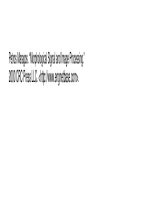Tài liệu Process Systems Analysis And Control P1 docx
Bạn đang xem bản rút gọn của tài liệu. Xem và tải ngay bản đầy đủ của tài liệu tại đây (3.15 MB, 30 trang )
PROCESS SYSTEMS ANALYSIS AND
CONTROL
McGraw-Hill Chemical Engineering Series
Editorial Advisory Board
James J. Carherry,
Professor of Chemical Engineering, University of Notre Dame
James
R. Fair, Professor of Chemical Engineering, University of Texas, Austin
William P. Schowalter,
Dean, School of Engineering, University of Illinois
Matthew
Professor of Chemical Engineering, University of Minnesota
James
of Chemical Engineering, Massachusetts Institute of Technology
Max S. Peters,
Emeritus, Professor of Chemical Engineering, University of Colorado
Building the Literature of a Profession
Fifteen prominent chemical engineers first met in New York more than 60 years
ago to plan a continuing literature for their rapidly growing profession. From
Industry came such pioneer practitioners as Leo H. Baekeland, Arthur D. Little,
Charles L. Reese, John N. M. C. Whitaker, and R. S. McBride. From
the universities came such eminent educators as William H. Walker, Alfred H.
White, D. D. Jackson, J. H. James, Warren K. Lewis, and Harry A. Curtis.
H. C. Parmelee, then editor of Chemical Engineering, served
as chairman and was joined subsequently by S. D. Kirkpatrick as consulting editor.
After several meetings, this committee submitted its report to the
Hill Book Company in September 1925. In the report were detailed specifications
for a correlated series of more than a dozen texts and reference books which
have since become the McGraw-Hill Series in Chemical Engineering and which
became the cornerstone of the chemical engineering curriculum.
From this beginning there has evolved a series of texts surpassing by far the
scope and longevity envisioned by the founding Editorial Board. The
Hill Series in Chemical Engineering stands as a unique historical record of the
development of chemical engineering education and practice. In the series one
finds the milestones of the subject’s evolution: industrial chemistry, stoichiometry,
unit operations and processes, thermodynamics, kinetics, process control, and
transfer operations.
Chemical engineering is a dynamic profession, and its literature continues
to evolve. McGraw-Hill, with its editor, B.J. Clark and its consulting editors,
remains committed to a publishing policy that will serve, and indeed lead, the
needs of the chemical engineering profession during the years to come.
The Series
Bailey and Ollis:
Biochemical Engineering Fundamentals
Bennett and
Myers: Momentum, Heat, and Mass Transfer
Brodkey and Hershey:
Transport Phenomena: A App
Carberry:
Chemical and Catalytic Reaction Engineering
Constantinides:
Applied Numerical Methods with Personal
Co
Coughanowr:
Process Systems Analysis and Control
Douglas:
Conceptual Design of Chemical Processes
and
Optimization of Chemical Processes
Gates, Katzer, and
Chemistry of Catalytic Processes
Holland:
Fundamentals of Multicomponent Distillation
Holland and Liapis:
Computer Methods for Solving Dynamic Separation Problems
Katz and Lee:
Natural Gas Engineering: Production and Storage
King: Separation Processes
Lee:
Fundamentals of Microelectronics Processing
Luyben:
Process Modeling, Simulation, and Control for Chemical Engineers
McCabe, Smith, J. C., and Unit Operations of Chemical Engineering
Sherwood, and Reed:
Applied Mathematics in Chemical Engineering
Nelson: Petroleum Engineering
Perry and Chilton (Editors): Perry’s Chemical Engineers’ Handbook
Peters:
Elementary Chemical Engineering
Peters and
Plant Design and Economics for Chemical Engineers
Reid, Prausnitz, and Rolling:
Properties of Gases and Liquids
Smith, J. M.: Chemical Engineering Kinetics
Smith, J. M., and Van
Ness: Introduction to Chemical Engineering Thermodynamics
Mass Transfer Operations
Valle-Riestra:
Project Evaluation in the Chemical Process Industries
Russell, and Swartzlander:
The Structure of the Chemical Processing Industries
Wentz:
Hazardous Waste Management
PROCESS SYSTEMS ANALYSIS
Second Edition
Donald R. Coughanowr
Department of Chemical Engineering
University
McGraw-Hill, Inc.
New York St. Louis San Francisco Auckland Caracas
Hamburg Lisbon London Madrid Mexico Milan Montreal New Delhi
Paris San Juan Singapore Sydney Tokyo Toronto
PROCESS SYSTEMS ANALYSIS AND CONTROL
International Edition 1991
Exclusive rights by McGraw-Hill Book Co.- Singapore for
manufacture and export. This book cannot be re-exported
from the country to which it is consigned by McGraw-Hill.
Copyright 1991, 1965 by McGraw-Hill,
All rights reserved. Except as permitted under the United States Copyright
Act of 1976, no part of this publication may be reproduced or distributed in
any form or by any means, or stored in a data base or retrieval system,
without the prior written permission of the publisher.
This book was set in Times by Publication Services.
The editors were B. J. Clark and John M. Morriss.
The production supervisor was Louise Karam.
The cover was designed by Hernandez.
Project supervision was done by Publication Services.
Library of Congress Cataloging in Publication Data
Coughanowr, Donald R.
Process systems analysis and control by Donald Ft. Coughanowr.
2nd ed.
cm. (McGraw-Hill chemical engineering series)
Includes index.
o-07-013212-7
1. Chemical process control.
Title.
Series.
1991
90-41740
When ordering this title use 0-07-l 00807-l
ABOUTTHEAUTHOR
Donald R. Coughanowr is the Fletcher Professor of Chemical Engineering at
Drexel University. He received a Ph.D. in chemical engineering from the Uni-
versity of Illinois in 1956, an degree in chemical engineering from the
University of Pennsylvania in 195 1, and a B . S. degree in chemical engineering
from the Rose-Hulman Institute of Technology in 1949. He joined the faculty
at Drexel University in 1967 as department head, a position he held until 1988.
Before going to Drexel, he was a faculty member of the School of Chemical
Engineering at Purdue University for eleven years.
At Drexel and Purdue he has taught a wide variety of courses, which in-
clude material and energy balances, thermodynamics, unit operations, transport
phenomena, petroleum refinery engineering, environmental engineering, chemical
engineering laboratory, applied mathematics, and process dynamics and control.
At Purdue, he developed a new course and laboratory in process control and col-
laborated with Dr. Lowell B. Koppel on the writing of the first edition of Process
Systems Analysis and Control.
His research interests include environmental engineering, diffusion with
chemical reaction, and process dynamics control; of his research in
control has emphasized the development and evaluation of algorithms
for processes that cannot be controlled easily by control; some of
the areas investigated are control, adaptive control, direct digital
control, and batch control of He has reported on his research in nu-
merous publications and has received support for research projects from, the N.S
and industry. He has spent sabbatical leaves teaching and writing at Case-Western
Reserve University, the Swiss, Federal Institute, the University of Canterbury, the
University of New South Wales, the University of Queensland, and Lehigh Uni-
versity.
Dr. Coughanowr’s industrial experience includes process design and pilot
plant at Standard Oil Co. (Indiana) and summer employment at Electronic Asso-
ciates and Dow Chemical Company.
ABOUT THE
AUTHOR
He is a member of the American Institute of Chemical Engineers, the Instru-
ment Society of America, and the American Society for Engineering Education.
He is also a delegate to the Council for Chemical Research. He has served the
by participating in accreditation visits to departments of chemical engi-
neering for. ABET and chairing sessions of the Department Heads Forum at
the annual meetings of
To
Effie, Corinne, Christine, and David
CONTENTS
Preface
xv
1 An Introductory Example
1
Part I The Transform
2
The
13
3
Inversion by Partial Fractions
22
4
Further Properties of Transforms
37
Part II Linear Open-Loop Systems
5
Response of First-Order Systems
6
Physical Examples of First-Order Systems
7
Response of First-Order Systems in Series
8 Higher-Order Systems: Second-Order
and Transportation Lag
49
64
80
90
Part III Linear Closed-Loop Systems
9
The Control System
111
10
Controllers and Final
Control Elements
123
11
Block Diagram of a Chemical-Reactor Control System
135
xii
12
Closed-Loop Transfer Functions
143
13
Transient Response of Simple Control Systems
151
14
Stability
164
15
Root Locus
177
Part IV Frequency Response
16 Introduction to Frequency Response
201
17
Control System Design by Frequency Response
224
Part V Process Applications
18
Advanced Control Strategies
249
19
Controller Tuning and Process Identification
282
20
Control Valves
303
21
Theoretical Analysis of Complex Processes
318
.
Part VI Sampled-Data Control Systems
22
Sampling and Z-Transforms
23
Open-Loop and Closed-Loop Response
24
Stability
25
Modified Z-Transforms
26
Sampled-Data Control of a First-Order Process
with Transport Lag
27
Design of Sampled-Data Controllers
349
360
376
384
-393
405
Part VII State-Space Methods
28
State-Space Representation ofPhysical Systems
431
29
Transfer Function Matrix
446
30
Multivariable Control
453









